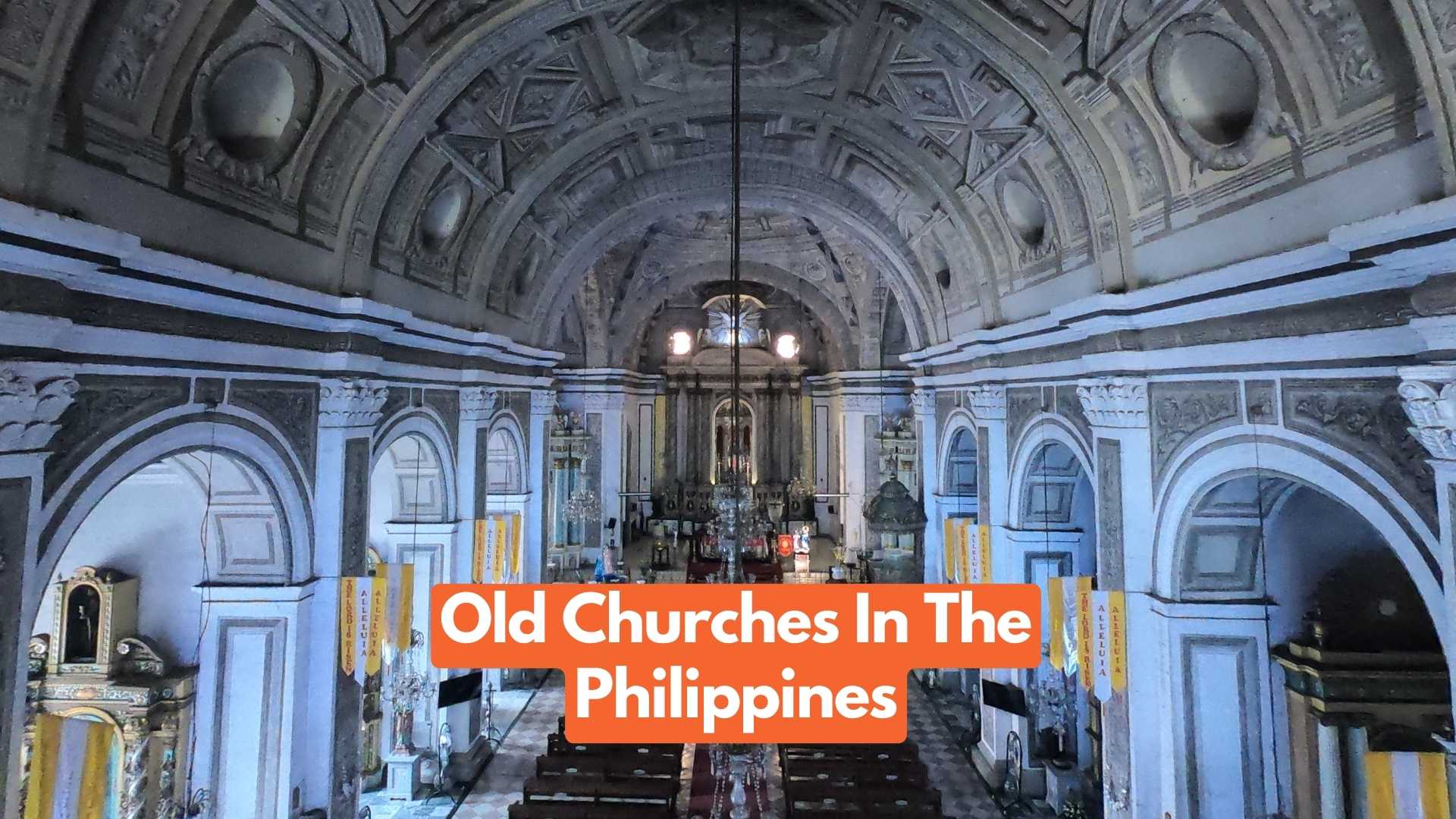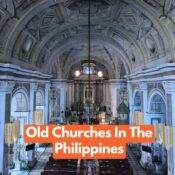
Exploring the Old Churches of the Philippines
Hello, Staycationers! It’s me, Louie Sison, your travel guide through the enchanting world of the Philippines. Today, we’re embarking on a journey unlike any other, exploring the “old churches in the Philippines.” These aren’t just buildings; they’re time capsules, each with a story whispering through their hallowed halls. So, grab your backpacks, and let’s dive into history and faith, Filipino style!
The Architectural Marvels of Philippine Baroque Churches
As we step into the realm of the Philippines’ Baroque Churches, we’re not just visiting structures; we’re witnessing a blend of history, art, and spirituality. These churches, listed as UNESCO World Heritage Sites, are more than just tourist spots; they’re a testament to the Philippines’ rich colonial past.
San Agustin Church, Manila
In the heart of Intramuros, Manila, stands the San Agustin Church. Completed in 1607, it’s the oldest stone church still standing in the Philippines. Its Baroque architecture, with intricate carvings and detailed frescoes, tells a story of resilience and faith. This church has seen Manila’s history unfold, surviving wars and natural disasters. It’s a place where every corner speaks of the past, and every visit feels like a step back in time.
Paoay Church, Ilocos Norte
Next, we head north to Ilocos Norte, where the Paoay Church, completed in 1710, awaits us. This church is a marvel of architecture with its enormous buttresses and unique combination of Gothic, Baroque, and Oriental designs. The church’s façade is a sight to behold, with intricate carvings that reflect the fusion of cultures that is so uniquely Filipino.
Miagao Church, Iloilo
Down south in Iloilo, the Miagao Church stands proudly. Built in 1786, it’s a fortress-like structure that has stood the test of time against Moro raiders. The church’s exterior is adorned with a unique blend of botanical and religious motifs, showcasing the creativity of Filipino artisans. Inside, the golden retablo and the rustic charm of its walls tell stories of faith that have been passed down through generations.
Journey Through Time: The Oldest Churches in the Philippines
As we delve deeper into our journey, we discover the oldest churches in the Philippines, each with a story that has shaped the nation’s history.
San Agustin Church, Manila
We revisit the San Agustin Church in Manila, not just for its architecture, but for its historical significance. This church has witnessed the ebb and flow of Philippine history, from the Spanish era to the present day. It’s a place where history buffs can spend hours exploring every nook and cranny, each filled with tales of the past.
Quipayo Church, Camarines Sur
In Camarines Sur, the Quipayo Church stands as one of the earliest structures built during the Spanish regime. This church is not just a religious site; it’s a symbol of the enduring faith of the Bicolanos. Its history is intertwined with the region’s cultural evolution, making it a must-visit for anyone interested in the Philippines’ colonial past.
Majayjay Church, Laguna
Heading to Laguna, the Majayjay Church, built in 1649, showcases a Romanesque architectural style. Its façade, with three levels and a triangular pediment, is a sight to behold. Inside, the church houses antique images of saints and century-old liturgical objects, each with a story to tell.
Top 10 Time-Tested Churches and Their Stories
Our journey wouldn’t be complete without exploring the top 10 oldest churches in the Philippines. Each of these churches has its own unique story, reflecting the diverse history and culture of the Filipino people.
- San Agustin Church, Manila: A testament to the resilience of Filipino faith.
- Basilica Minore del Santo Niño, Cebu: Home to the oldest religious relic in the Philippines.
- Church of San Juan Bautista, Iloilo: A magnificent structure with a storied past.
- Nuestra Señora de Gracia Church, Ilocos Sur: A blend of Spanish colonial architecture and Filipino craftsmanship.
- Santa Maria Church, Ilocos Sur: A church on a hill, offering breathtaking views and a serene atmosphere.
- San Sebastian Church, Manila: A Neo-Gothic architectural marvel in the heart of Manila.
- Miag-ao Church, Iloilo: A fortress-like church with a unique exterior.
- Lazi Church, Siquijor: A quaint church on an idyllic island.
- Loboc Church, Bohol: A historic church with a rich cultural heritage.
- Baclayon Church, Bohol: One of the oldest churches in the Philippines, with a history dating back to 1595.
Each of these churches offers a unique glimpse into the Philippines’ past, making them must-visit destinations for history enthusiasts and cultural explorers alike.
Must-Visit Churches for Historical and Cultural Enthusiasts
As we continue our journey, let’s explore some churches that are not just places of worship but also hubs of culture and history.
Mt. Carmel Chapel, Batanes
In the serene hills of Batanes, the Mt. Carmel Chapel, also known as Tukon Church, stands as a testament to Ivatan architecture. This stone church, inspired by traditional Ivatan houses, offers a panoramic view of the island. It’s a place of tranquility, where one can feel the blend of nature and spirituality.
Binondo Church, Manila
In the bustling streets of Binondo, Manila’s Chinatown, lies the Binondo Church. This church, with its rich history intertwined with Filipino-Chinese culture, offers a unique blend of architectural styles. It’s a place where diverse cultures and histories converge, making it a fascinating site for cultural enthusiasts.
Caleruega Church, Batangas
Heading to the south of Luzon, in Batangas, Caleruega Church emerges as a popular retreat place. Known as the “Transfiguration Chapel,” this church is not just a religious site but also a haven for nature lovers. Surrounded by lush greenery and with a view of the Batulao Mountains, it’s a perfect escape from the hustle and bustle of city life.
The Legacy of Faith: A Look at the Philippines’ Oldest Churches
In this section, we delve into the heart and soul of Filipino spirituality by exploring some of the oldest churches in the country.
San Agustin Church, Manila
Revisiting the San Agustin Church, we delve deeper into its historical significance. This church is not just an architectural marvel but also a repository of art and history. Its museum houses religious artifacts and antiquities, offering a glimpse into the Philippines’ colonial past.
St. James the Great Parish Church, Bolinao
In Bolinao, Pangasinan, the St. James the Great Parish Church stands as a fortress-like structure. Built in 1609, this church is home to rare wooden statues and an antique side altar with Aztec-like carvings. It’s a place where history and artistry blend seamlessly.
Our Lady of Mt Carmel Parish, Malolos
In Malolos, Bulacan, the Barasoain Church, built in 1630, is a site of great historical importance. Known as the “Cradle of Democracy in the East,” this church has witnessed significant events in Philippine history. It’s a place where one can feel the pulse of the nation’s struggle for freedom.
Architectural and Artistic Aspects
In this section, we explore the artistic and architectural elements that make these churches unique.
Baroque, Gothic, and Renaissance Influences
The old churches of the Philippines showcase a blend of various architectural styles. From the intricate Baroque details of San Agustin Church to the Gothic features of San Sebastian Church and the Renaissance touches in Miagao Church, each style tells a story of the cultural influences that shaped the Philippines.
Art and Iconography
The art and iconography in these churches are not just decorations; they are narratives of faith and history. The frescoes, carvings, and statues in churches like San Agustin and Miagao Church depict biblical stories, local history, and the fusion of different cultures.
Churches as Centers of Community and Faith
These churches are not just buildings; they are vibrant centers of community life.
Role in the Community
In the Philippines, churches are more than places of worship; they are integral to community life. They host festivals, weddings, baptisms, and other community events, serving as gathering places for celebration and solace.
Festivals and Traditions
Many churches in the Philippines are associated with local festivals and traditions. For instance, the Sinulog Festival in Cebu, centered around the Basilica Minore del Santo Niño, is a vibrant celebration of Filipino faith and culture.
Personal Narratives and Community Stories
Each church has its own set of stories and legends, passed down through generations. These narratives add a personal touch to each visit, making the experience more meaningful and relatable.
Conservation and Challenges
As we appreciate these historical treasures, it’s important to recognize the efforts to preserve them and the challenges they face.
Conservation Efforts
Preserving these old churches is a monumental task. Efforts by the government and various organizations aim to maintain their structural integrity and historical value. This includes restoration projects and awareness campaigns to educate the public about their significance.
Challenges Faced
These churches face numerous challenges, from natural disasters like earthquakes and typhoons to the effects of modernization. Balancing preservation with the needs of a growing community is a delicate task.
Impact of Modernization
Modernization poses a significant threat to these historical sites. Urban development and changing lifestyles can lead to neglect or inappropriate renovations. It’s crucial to find a balance that allows for modernization while preserving historical integrity.
A Traveler’s Guide to Visiting
Alright, Staycationers, let’s talk about how you can make the most of your visits to these historical gems.
Practical Information for Tourists
When planning your visit, consider the weather and local events. Most churches are open daily, but it’s best to check for any special events or services. Dress respectfully, as these are places of worship. And don’t forget, some of these churches are in remote areas, so plan your transportation accordingly.
Travel Itinerary Recommendations
Create an itinerary that allows you to immerse yourself in the history and culture of each location. For instance, start in Manila with the San Agustin Church, then head north to Ilocos for the Paoay Church, and down to Iloilo for the Miagao Church. Each region offers unique experiences, so take your time to explore.
Tips for a Full Experience
To truly appreciate these churches, engage with the local community. Attend a mass if you can, or visit during a festival. And don’t just stick to the church; explore the surrounding areas for a complete cultural experience.
Conclusion
As we wrap up our journey through the old churches of the Philippines, it’s clear that these are not just structures made of stone and wood. They are living testaments to the Filipino spirit, resilience, and faith. They tell stories of our past and offer lessons for our future. So, I encourage you, my fellow Staycationers, to explore these churches and experience the rich tapestry of Filipino history and culture.
Additional Resources
For those who want to delve deeper, there are plenty of resources available. Check out documentaries on Philippine history, books on Filipino architecture, and even guided tours that offer in-depth insights into these historical sites.
Final Thoughts
Staycationers, our journey through the old churches of the Philippines has been a journey through time, culture, and faith. These churches are more than just tourist spots; they are a vital part of our Filipino heritage. They remind us of our past struggles, our enduring faith, and our rich cultural tapestry. As we continue to explore the beauty of the Philippines, let’s remember to cherish and preserve these treasures for future generations. Keep exploring, keep learning, and keep enjoying the beauty of our beloved Philippines. Mabuhay!




